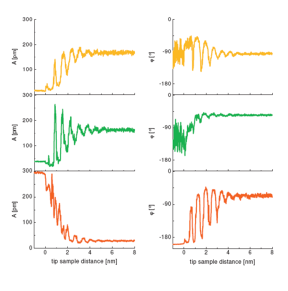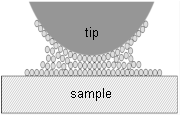Understanding the properties of liquids confined between solid surfaces is of fundamental importance to many technological problems like lubrication, adhesion and lithography. When a liquid is confined to small scales it behaves different from the bulk.



Figure: Amplitude and phase of the AFM cantilever vs separation between the solid HOPG surface and the cantilever tip for different drive frequencies top/yellow: 41 kHz w/w0=0.95, middle/green: 32 kHz w/w0=0.75, and bottom/red: 6 kHz w/w0=0.15 relative to resonance (43 kHz). The periodicity of the oscillations reflects the size of the molecules (OMCTS).
A specifically interesting confinement effect is called layering. Close to the solid wall the liquid molecules tend to structure and form layers (Figure1). By driving the Atomic Force Microscope (AFM) cantilever with a very small amplitude (<100pm) we are able to study both the conservative as the dissipative forces of this nanoconfined liquid.
To find these forces it is crucial to accurately model the AFM. In the AFM community the cantilever is in general described as a harmonic oscillator. We found that in highly damped systems (in liquid) it is necessary to explicitly include the base-motion of the driving mechanism in the description of the cantilever dynamics.
We are especially interested in the effect of temperature on the conservative and dissipative oscillatory forces (due to layering).
Recently we won the Veeco HarmoniX research grant, which is used to study the effect of capillary condensation on gecko-feet adhesion and the elasticity of surface nanobubbles.
More information:
- contact: Sissi de Beer, Frieder Mugele
